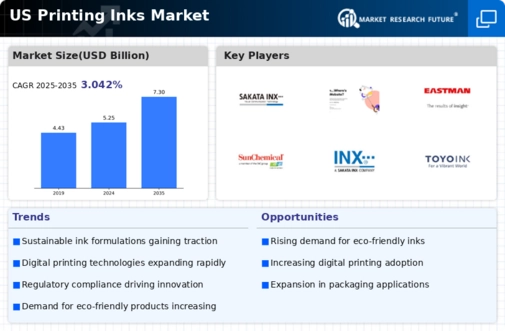The US Printing Inks Market is characterized by a dynamic competitive landscape driven by innovation, evolving customer preferences, and the increasing demand for environmentally friendly products. Various players in this sector engage in rigorous research and development to stay ahead, focusing on product differentiation and sustainability to meet the changing needs of industries such as packaging, commercial printing, and publishing.
The competition is intensified by the presence of both large multinational corporations and smaller specialized firms, each aiming to capture market share through enhanced performance and cost-effectiveness. The market is also affected by factors such as raw material availability, regulatory frameworks concerning environmental compliance, and technological advancements that streamline production processes and improve product quality.
Sakata Inx has established itself as a significant player within the US Printing Inks Market, leveraging its strengths in product innovation and a wide array of offerings to cater to diverse printing needs. Known for its commitment to sustainability, Sakata Inx focuses on developing inks that are both efficient and environmentally friendly, appealing to businesses seeking to reduce their ecological footprint. The company's robust research and development efforts ensure that it stays at the forefront of technological advancements in printing inks.
Furthermore, its strong distribution network and customer service capabilities enable Sakata Inx to maintain a solid presence in the market, empowering it to effectively meet customer demands while building lasting relationships with clients across various sectors. Flint Group is another prominent entity in the US Printing Inks Market, offering an extensive range of products that cater to different printing applications, including sheetfed, web, and liquid inks. With a deep commitment to innovation, Flint Group invests significantly in research and development to create high-performance inks that meet stringent quality standards.
The company is well-regarded for its strengths in operational efficiency, supply chain management, and customer-centric solutions. Flint Group's strategic mergers and acquisitions have further enhanced its market presence, allowing it to expand its product portfolio and capabilities in the US. By integrating advanced technologies into its manufacturing processes, Flint Group not only improves its product offerings but also reinforces its reputation for quality and reliability in the competitive US Printing Inks Market.



















Leave a Comment